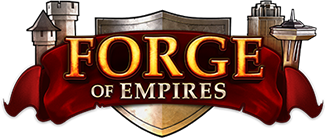Gilden-Expeditionen: Unterschied zwischen den Versionen
Oliver (Diskussion | Beiträge) Keine Bearbeitungszusammenfassung |
Oliver (Diskussion | Beiträge) (Änderung 6663 von Oliver (Diskussion) rückgängig gemacht.) |
||
| Zeile 1: | Zeile 1: | ||
== Stationen | == Was sind die Gilden-Expeditionen? == | ||
Die | Gilden-Expeditionen sind ein plattformübergreifendes Feature, bei dem du und deine Gilden-Mitglieder den Weg durch mehrere Stationen eines Dschungels bestreiten müssen und dabei Belohnungen und Gildenmacht erhalten. | ||
Die Expeditionen starten automatisch jeden Dienstag und dauern 6 Tage. Jeder Spieler einer Gilde, der mindestens die Eisenzeit erreicht hat, wenn die Gilden-Expeditionen starten, kann an ihnen teilnehmen. Die Gilden-Expedition ist über das Menü erreichbar. | |||
Wenn du eine Gilde gründest oder einer beitrittst, nachdem die Gilden-Expeditionen bereits gestartet sind, musst du bis zum nächsten Dienstag warten. | |||
== Die Karte der Gilden-Expeditionen == | |||
[[File:ExpeditionMap.png|center|link=]] | |||
Die Karte hat wie zu erkennen ein Dschungel-Thema und hat auch eine angepasste Musik. Jeder Spieler einer Gilde hat seine eigene Karte, die gesammelte Macht gilt jedoch für die gesamte Gilde. | |||
Die Leiste zählt die sogenannten '''Expeditions-Punkte'''. Wenn deine Gilde ein neues Ziel erreicht, erhält sie eine gewisse Menge Macht dazu. Die Macht dabei wird jeden Tag bei der täglichen Abrechnung hinzugefügt. Mit einem Klick auf die Leiste kannst du weitere Details erhalten. | |||
[[File:ExpeditionGoalBar.png|center|link=]] | |||
Die Expeditions-Punkte erhältst du durch das Gewinnen der Stationen auf der Karte. Diese kannst du durch das Bekämpfen oder durch das Verhandeln einnehmen. Nach jeder Station kannst du Belohnungen aus einer Truhe einsammeln. | |||
Wenn du weiter kommst, wird auch der Nebel auf der Karte verschwinden und weitere Stationen und Truhen freigeben. Beachte, dass die 'größeren' Stationen schwieriger sind als die kleinen. Wenn du dich auf der Karte verlaufen hast, zeigt dir der große goldene Pfeil immer deine aktuelle Position an. | |||
== Solving Encounters == | |||
The amount of consecutive encounter solving attempts is limited to 8 and each time you begin a battle or spend resources in a negotiation game, 1 attempt point is withdrawn. You can see the amount of attempts you still have on the attempts bar: | |||
[[File:ExpeditionAttempts.png|center|link=]] | [[File:ExpeditionAttempts.png|center|link=]] | ||
When you run out of them, you can either wait for them to regenerate (you get 1 per hour) or buy them with medals (or Diamonds). The medals price for each attempt will rise as you purchase more. At the end of the Expedition the cost will reset, so you will have a fresh start each week. | |||
Regardless of the outcome of your attempt, you will contribute some expedition points to the guild progress bar (obviously if you lose, it won't be that much). The guild goals depend on the number and era of the guild members (these are set when the expeditions begin, they will not change even if you gain or lose guild members over the week) and are shared between all guild members. | |||
=== | === Fighting === | ||
As we mentioned, you can solve encounters in one of two ways - fighting or negotiation. Fighting should already be known to you, because it is the same as everywhere in the game (the Continent Map, PvP, and GvG). | |||
The units' age and the overall difficulty of the encounters depend on your own advancement in the tech tree when the expedition begins. You may also face two-wave battles, as well as units with boosted attack/defense depending on your own era. | |||
=== | === Negotiation === | ||
When you hit the Negotiate button for the first time, you will see that you get approached by five locals. They will each want a specific resource from you, but they will not tell you which one! You will be able to select and offer resources to them: | |||
[[File:NegotiationGame1.png|center|link=]] | [[File:NegotiationGame1.png|center|link=]] | ||
Once you have selected the resources, you can hit the 'Negotiate' button (at this point 1 attempt will be withdrawn from your attempts bar). Keep in mind that you will also be giving away these resources to the locals from your personal stock. The locals will then provide you with feedback on your guess, which will look like this: | |||
[[File:NegotiationGameFeedback.png|center|link=]] | [[File:NegotiationGameFeedback.png|center|link=]] | ||
* ''' | * '''Correct''' - your offer was accepted! However, other locals may also want this resource (though not necessarily). | ||
* ''' | * '''Wrong Person''' - your offer was rejected. But at least one other local is searching for this resource! | ||
* ''' | * '''Incorrect''' - your offer was rejected, and no local needs this resource (it will also be grayed out in the resource selection window on your next turn). | ||
You have likely noticed the negotiation window has 'Turns' - this is because the locals want you to give them the correct resources in 3 turns. Every time you select 5 resources and hit 'Negotiate', you will spend a turn: | |||
[[File:NegotationGame2.png|center|link=]] | [[File:NegotationGame2.png|center|link=]] | ||
Once you've spent all 3 turns, you can only buy a turn with diamonds or give up the attempt and come back at a later time. If you decide to give up and try again later, the set of resources you can choose from will remain the same, but who wants what among the locals will be randomly changed. | |||
== Expedition Difficulties == | |||
The expedition map can be completed not once, but three times per week! To conquer the map again, you have to unlock higher difficulties (level II and III). Click the star icon in the top left corner to open the difficulties overview: | |||
[[File:ExpeditionsDifficulties.png|center|link=]] | |||
As you can see, the default difficulty is I and it's available for free. To unlock the higher ones, a guild leader or founder has to pay goods from the guild treasury. But everyone can donate the goods to the guild treasury, only spending them is limited to leaders/founders. | |||
The [[Kosten für das Freischalten der Schwierigkeitsstufen]] depend on the age and number of your guild members when the expedition beings. Each player in your guild will generate a cost based on their age. Your guild will need to pay the cumulative cost for all guild members in order to unlock the difficulty. Unlocking a difficulty makes it available to all guild members who are taking part in the current Expedition. | |||
== Temple of Relics == | |||
The [[Temple of Relics]] is a Great Building designed specifically for fans of Guild Expeditions. You can get blueprints for it either by solving encounters in expeditions, or by contributing to the same Great Building in cities of other players. It has only one passive bonus - the Relic Hunt ability. | |||
[[File:Ge_hud_relic_inactive.png|center|link=]] | |||
Relic Hunt gives you a chance to find special rewards whenever you solve an encounter in an expedition. You will locate an icon on the right hand side on the expedition map - when it's highlighted it means there is at least 1 relic on the map that you can collect. If a relic is under a fogged area, you will need to progress on the map for the fog to disappear so that you can collect the relic. Make sure you collect any relics before proceeding to the next difficulty as any uncollected relics will disappear! | |||
[[File:Ge_hud_relic.png|center|link=]] | |||
The rewards come in 3 groups, each of them a different type of relic - common, uncommon, and rare. Of course the chances are higher to get a common relic, and lower to get a rare relic. But this changes as your Temple of Relics levels up - the chances to win a rare relic will increase with each level, while the ones for a common relic will decrease. | |||
Here is an overview of what rewards these relics can give you, and the respective probability to win those specific rewards. | |||
{| style="text-align:center;" | |||
!style="text-align: center;"| Common | |||
(Silver) | |||
![[File:ge_relic_common.png|50px|center|link=]] | |||
!style="text-align: center;"| Uncommon | |||
(Gold) | |||
![[File:ge_relic_uncommon.png|50px|center|link=]] | |||
!style="text-align: center;"| Rare | |||
(Jade) | |||
![[File:ge_relic_rare.png|50px|center|link=]] | |||
|- | |||
| <div style="text-align: center;">20 Forge Points</div> | |||
| <div style="text-align: center;">10%</div> | |||
| <div style="text-align: center;">100 Forge Points</div> | |||
| <div style="text-align: center;">20%</div> | |||
| <div style="text-align: center;">Oasis</div> | |||
| <div style="text-align: center;">35%</div> | |||
|- | |||
| <div style="text-align: center;">25 Goods (1 type)</div> | |||
| <div style="text-align: center;">20%</div> | |||
| <div style="text-align: center;">200 Goods (1 type)</div> | |||
| <div style="text-align: center;">20%</div> | |||
| <div style="text-align: center;">Bazaar</div> | |||
| <div style="text-align: center;">35%</div> | |||
|- | |||
| <div style="text-align: center;">5 Light Units</div> | |||
| <div style="text-align: center;">3%</div> | |||
| <div style="text-align: center;">10 Rogues</div> | |||
| <div style="text-align: center;">12,5%</div> | |||
| <div style="text-align: center;">Shrine of Knowledge</div> | |||
| <div style="text-align: center;">10%</div> | |||
|- | |||
| <div style="text-align: center;">5 Ranged Units</div> | |||
| <div style="text-align: center;">3%</div> | |||
| <div style="text-align: center;">Watchfire</div> | |||
| <div style="text-align: center;">35%</div> | |||
| <div style="text-align: center;">Wishing Well</div> | |||
| <div style="text-align: center;">10%</div> | |||
|- | |||
| <div style="text-align: center;">5 Fast Units</div> | |||
| <div style="text-align: center;">3%</div> | |||
| <div style="text-align: center;">Small Medals Package</div> | |||
| <div style="text-align: center;">12,5%</div> | |||
| <div style="text-align: center;">Renovation Kit</div> | |||
| <div style="text-align: center;">10%</div> | |||
|- | |||
| <div style="text-align: center;">5 Heavy Units</div> | |||
| <div style="text-align: center;">3%</div> | |||
|- | |||
| <div style="text-align: center;">5 Artillery Units</div> | |||
| <div style="text-align: center;">3%</div> | |||
|- | |||
| <div style="text-align: center;">Premium Decoration</div> | |||
| <div style="text-align: center;">25%</div> | |||
|- | |||
| <div style="text-align: center;">Double Blueprint</div> | |||
| <div style="text-align: center;">30%</div> | |||
|- | |||
|} | |||
Version vom 3. September 2016, 19:04 Uhr
Was sind die Gilden-Expeditionen?
Gilden-Expeditionen sind ein plattformübergreifendes Feature, bei dem du und deine Gilden-Mitglieder den Weg durch mehrere Stationen eines Dschungels bestreiten müssen und dabei Belohnungen und Gildenmacht erhalten.
Die Expeditionen starten automatisch jeden Dienstag und dauern 6 Tage. Jeder Spieler einer Gilde, der mindestens die Eisenzeit erreicht hat, wenn die Gilden-Expeditionen starten, kann an ihnen teilnehmen. Die Gilden-Expedition ist über das Menü erreichbar.
Wenn du eine Gilde gründest oder einer beitrittst, nachdem die Gilden-Expeditionen bereits gestartet sind, musst du bis zum nächsten Dienstag warten.
Die Karte der Gilden-Expeditionen

Die Karte hat wie zu erkennen ein Dschungel-Thema und hat auch eine angepasste Musik. Jeder Spieler einer Gilde hat seine eigene Karte, die gesammelte Macht gilt jedoch für die gesamte Gilde.
Die Leiste zählt die sogenannten Expeditions-Punkte. Wenn deine Gilde ein neues Ziel erreicht, erhält sie eine gewisse Menge Macht dazu. Die Macht dabei wird jeden Tag bei der täglichen Abrechnung hinzugefügt. Mit einem Klick auf die Leiste kannst du weitere Details erhalten.
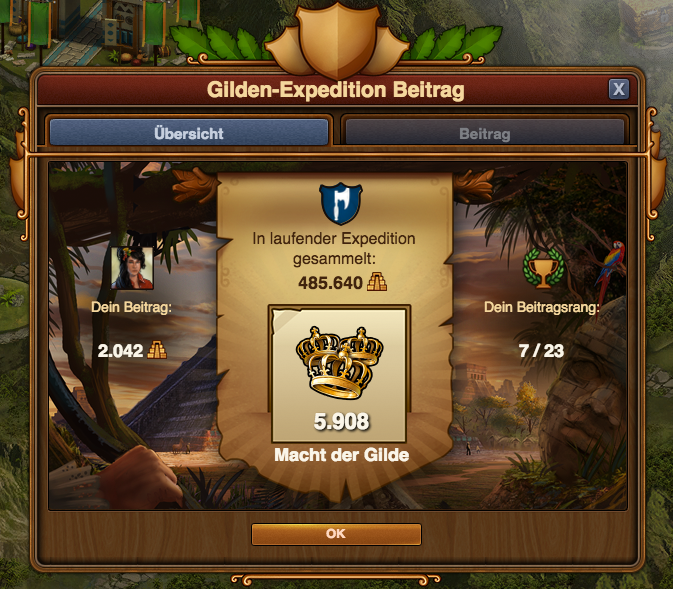
Die Expeditions-Punkte erhältst du durch das Gewinnen der Stationen auf der Karte. Diese kannst du durch das Bekämpfen oder durch das Verhandeln einnehmen. Nach jeder Station kannst du Belohnungen aus einer Truhe einsammeln.
Wenn du weiter kommst, wird auch der Nebel auf der Karte verschwinden und weitere Stationen und Truhen freigeben. Beachte, dass die 'größeren' Stationen schwieriger sind als die kleinen. Wenn du dich auf der Karte verlaufen hast, zeigt dir der große goldene Pfeil immer deine aktuelle Position an.
Solving Encounters
The amount of consecutive encounter solving attempts is limited to 8 and each time you begin a battle or spend resources in a negotiation game, 1 attempt point is withdrawn. You can see the amount of attempts you still have on the attempts bar:

When you run out of them, you can either wait for them to regenerate (you get 1 per hour) or buy them with medals (or Diamonds). The medals price for each attempt will rise as you purchase more. At the end of the Expedition the cost will reset, so you will have a fresh start each week.
Regardless of the outcome of your attempt, you will contribute some expedition points to the guild progress bar (obviously if you lose, it won't be that much). The guild goals depend on the number and era of the guild members (these are set when the expeditions begin, they will not change even if you gain or lose guild members over the week) and are shared between all guild members.
Fighting
As we mentioned, you can solve encounters in one of two ways - fighting or negotiation. Fighting should already be known to you, because it is the same as everywhere in the game (the Continent Map, PvP, and GvG).
The units' age and the overall difficulty of the encounters depend on your own advancement in the tech tree when the expedition begins. You may also face two-wave battles, as well as units with boosted attack/defense depending on your own era.
Negotiation
When you hit the Negotiate button for the first time, you will see that you get approached by five locals. They will each want a specific resource from you, but they will not tell you which one! You will be able to select and offer resources to them:
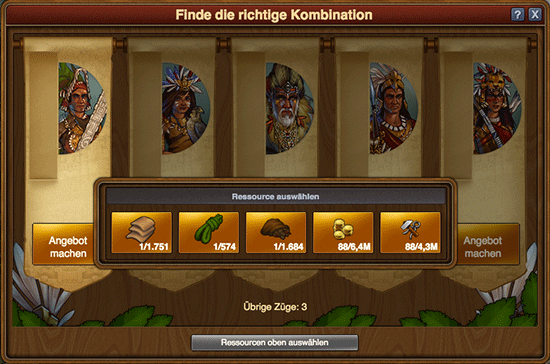
Once you have selected the resources, you can hit the 'Negotiate' button (at this point 1 attempt will be withdrawn from your attempts bar). Keep in mind that you will also be giving away these resources to the locals from your personal stock. The locals will then provide you with feedback on your guess, which will look like this:

- Correct - your offer was accepted! However, other locals may also want this resource (though not necessarily).
- Wrong Person - your offer was rejected. But at least one other local is searching for this resource!
- Incorrect - your offer was rejected, and no local needs this resource (it will also be grayed out in the resource selection window on your next turn).
You have likely noticed the negotiation window has 'Turns' - this is because the locals want you to give them the correct resources in 3 turns. Every time you select 5 resources and hit 'Negotiate', you will spend a turn:
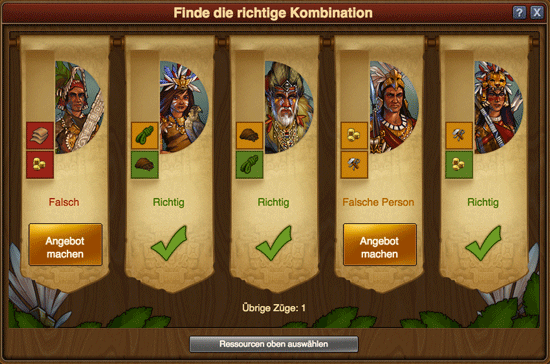
Once you've spent all 3 turns, you can only buy a turn with diamonds or give up the attempt and come back at a later time. If you decide to give up and try again later, the set of resources you can choose from will remain the same, but who wants what among the locals will be randomly changed.
Expedition Difficulties
The expedition map can be completed not once, but three times per week! To conquer the map again, you have to unlock higher difficulties (level II and III). Click the star icon in the top left corner to open the difficulties overview:
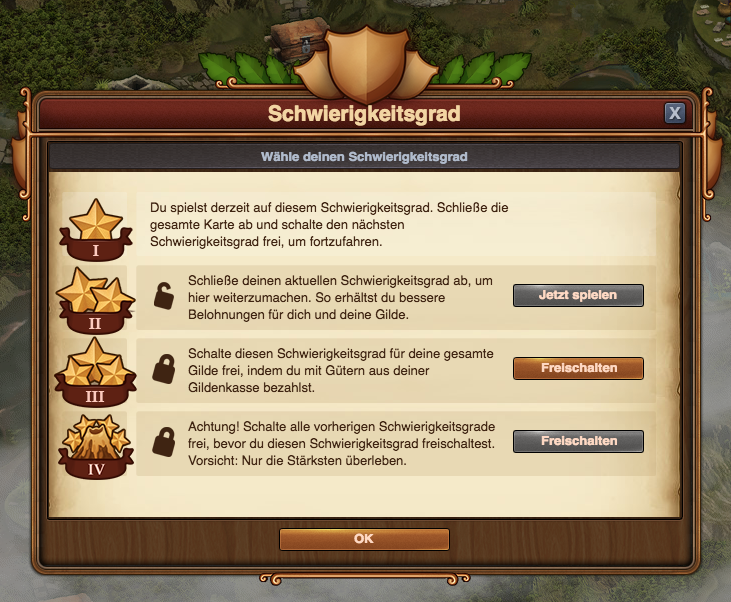
As you can see, the default difficulty is I and it's available for free. To unlock the higher ones, a guild leader or founder has to pay goods from the guild treasury. But everyone can donate the goods to the guild treasury, only spending them is limited to leaders/founders.
The Kosten für das Freischalten der Schwierigkeitsstufen depend on the age and number of your guild members when the expedition beings. Each player in your guild will generate a cost based on their age. Your guild will need to pay the cumulative cost for all guild members in order to unlock the difficulty. Unlocking a difficulty makes it available to all guild members who are taking part in the current Expedition.
Temple of Relics
The Temple of Relics is a Great Building designed specifically for fans of Guild Expeditions. You can get blueprints for it either by solving encounters in expeditions, or by contributing to the same Great Building in cities of other players. It has only one passive bonus - the Relic Hunt ability.

Relic Hunt gives you a chance to find special rewards whenever you solve an encounter in an expedition. You will locate an icon on the right hand side on the expedition map - when it's highlighted it means there is at least 1 relic on the map that you can collect. If a relic is under a fogged area, you will need to progress on the map for the fog to disappear so that you can collect the relic. Make sure you collect any relics before proceeding to the next difficulty as any uncollected relics will disappear!

The rewards come in 3 groups, each of them a different type of relic - common, uncommon, and rare. Of course the chances are higher to get a common relic, and lower to get a rare relic. But this changes as your Temple of Relics levels up - the chances to win a rare relic will increase with each level, while the ones for a common relic will decrease.
Here is an overview of what rewards these relics can give you, and the respective probability to win those specific rewards.
| Common
(Silver) |
 |
Uncommon
(Gold) |
 |
Rare
(Jade) |
 |
|---|---|---|---|---|---|
20 Forge Points
|
10%
|
100 Forge Points
|
20%
|
Oasis
|
35%
|
25 Goods (1 type)
|
20%
|
200 Goods (1 type)
|
20%
|
Bazaar
|
35%
|
5 Light Units
|
3%
|
10 Rogues
|
12,5%
|
Shrine of Knowledge
|
10%
|
5 Ranged Units
|
3%
|
Watchfire
|
35%
|
Wishing Well
|
10%
|
5 Fast Units
|
3%
|
Small Medals Package
|
12,5%
|
Renovation Kit
|
10%
|
5 Heavy Units
|
3%
| ||||
5 Artillery Units
|
3%
| ||||
Premium Decoration
|
25%
| ||||
Double Blueprint
|
30%
|
